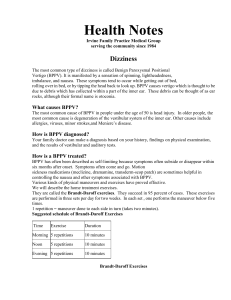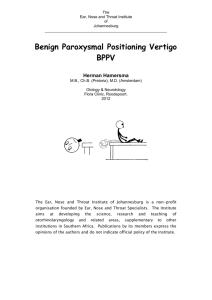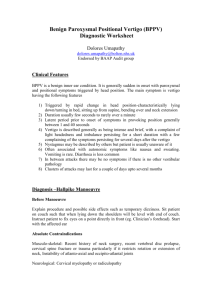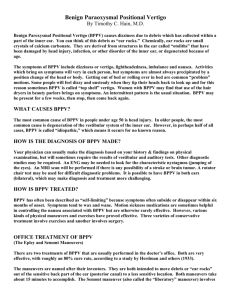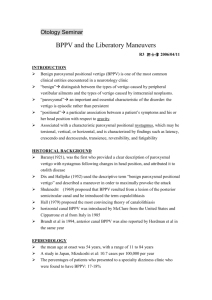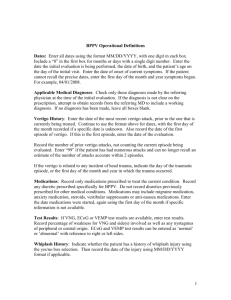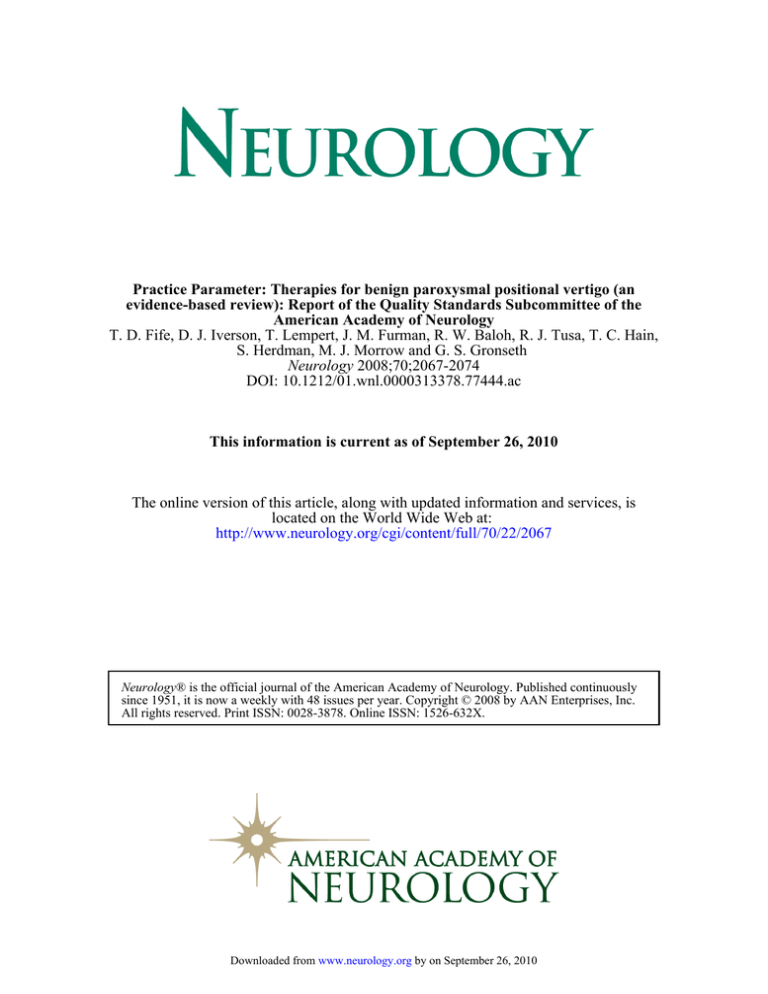
Practice Parameter: Therapies for benign paroxysmal positional vertigo (an
evidence-based review): Report of the Quality Standards Subcommittee of the
American Academy of Neurology
T. D. Fife, D. J. Iverson, T. Lempert, J. M. Furman, R. W. Baloh, R. J. Tusa, T. C. Hain,
S. Herdman, M. J. Morrow and G. S. Gronseth
Neurology 2008;70;2067-2074
DOI: 10.1212/01.wnl.0000313378.77444.ac
This information is current as of September 26, 2010
The online version of this article, along with updated information and services, is
located on the World Wide Web at:
http://www.neurology.org/cgi/content/full/70/22/2067
Neurology® is the official journal of the American Academy of Neurology. Published continuously
since 1951, it is now a weekly with 48 issues per year. Copyright © 2008 by AAN Enterprises, Inc.
All rights reserved. Print ISSN: 0028-3878. Online ISSN: 1526-632X.
Downloaded from www.neurology.org by on September 26, 2010
SPECIAL ARTICLE
Practice Parameter: Therapies for benign
paroxysmal positional vertigo
(an evidence-based review)
Report of the Quality Standards Subcommittee of the American
Academy of Neurology
T.D. Fife, MD
D.J. Iverson, MD
T. Lempert, MD
J.M. Furman, MD,
PhD
R.W. Baloh, MD
R.J. Tusa, MD, PhD
T.C. Hain, MD
S. Herdman, PT, PhD,
FAPTA
M.J. Morrow, MD
G.S. Gronseth, MD
Address correspondence and
reprint requests to the
American Academy of
Neurology, 1080 Montreal
Ave., St. Paul, MN 55116
guidelines@aan.com
Benign paroxysmal positional
vertigo (BPPV) is a clinical syndrome characterized by brief recurrent episodes of vertigo triggered by changes in head position with respect to
gravity. BPPV is the most common cause of recurrent vertigo, with a lifetime prevalence of 2.4%.1
The term BPPV excludes vertigo caused by lesions of the CNS. BPPV results from abnormal
stimulation of the cupula within any of the three
semicircular canals (figure e-1 on the Neurology®
Web site at www.neurology.org); most cases of
BPPV affect the posterior canal. The cupular excitatory response is usually related to movement of
otoliths (calcium carbonate crystals) that create a
current of endolymph within the affected semicircular canal. The most common form of BPPV occurs when otoliths from the macula of the utricle fall
into the lumen of the posterior semicircular canal
responding to the effect of gravity. These ectopic
otoliths, which have been observed intraoperatively,
are referred to as canaliths. The canaliths are dense
and move in the semicircular canal when the head
position is changed with respect to gravity; the canalith movement ultimately deflects the cupula, leading to a burst of vertigo and nystagmus. In some
cases, canaliths adhere to the cupula, causing cupulolithiasis, which is a form of BPPV less responsive
to treatment maneuvers.
Typical signs of BPPV are evoked when the
head is positioned so that the plane of the affected
semicircular canal is spatially vertical and thus
INTRODUCTION
aligned with gravity. This produces a paroxysm
of vertigo and nystagmus after a brief latency. Positioning the head in the opposite direction reverses the direction of the nystagmus. These
responses often fatigue upon repeat positioning.
The duration, frequency, and intensity of symptoms
of BPPV vary, and spontaneous recovery occurs frequently. Table e-1 outlines the characteristics of
BPPV by canal type.
Repositioning maneuvers are believed to treat
BPPV by moving the canaliths from the semicircular canal to the vestibule from which they are
absorbed. There are a number of repositioning
maneuvers in use, but they lack standardization.
The figures and Web-based video clips do not include all variations but represent those maneuvers
and treatments used in the Class I and Class II
studies that are reviewed as well as several others
in common use.
This practice parameter seeks to answer the following questions: 1) What maneuvers effectively
treat posterior canal BPPV? 2) Which maneuvers are
effective for anterior and horizontal canal BPPV? 3)
Are postmaneuver restrictions necessary? 4) Is concurrent mastoid vibration important for efficacy of
the maneuvers? 5) What is the efficacy of habituation exercises, Brandt–Daroff exercises, or patient
self-administered treatment maneuvers? 6) Are medications effective for BPPV? 7) Is surgical occlusion
of the posterior canal or singular neurectomy effective for BPPV?
GLOSSARY
Supplemental data at
www.neurology.org
AAN ⫽ American Academy of Neurology; BPPV ⫽ benign paroxysmal positional vertigo; CONSORT ⫽ Consolidated Standards of Reporting Trials; CRP ⫽ canalith repositioning procedure; NNT ⫽ number needed to treat.
From the Barrow Neurological Institute and University of Arizona College of Medicine (T.D.F.), Phoenix, AZ; Humboldt Neurological
Medical Group, Inc. (D.J.I.), Eureka, CA; Department of Neurology (T.L.), Schlosspark-Klinik, Berlin, Germany; Department of
Otolaryngology (J.M.F.), University of Pittsburgh, PA; Department of Neurology (R.W.B.), Reed Neurological Research Center, University
of California, Los Angeles, CA; Departments of Neurology (R.J.T.) and Rehabilitation Medicine (S.H.), Emory University; Atlanta, GA;
Northwestern University (T.C.H.), Chicago, IL; Providence Multiple Sclerosis Center (M.J.M.), Portland, OR; and University of Kansas
(G.S.G.), Kansas City, KS.
Approved by the Quality Standards Subcommittee on May 1, 2007; by the Practice Committee on June 21, 2007; and by the American
Academy of Neurology Board of Directors in July 2007.
QSS Subcommittee members, AAN classification of evidence, Classification of recommendations, Conflict of Interest Statement, Mission
Statement of the QSS, and references e1– e32 are available as supplemental data on the Neurology® Web site at www.neurology.org.
Disclosure: Author disclosures are provided at the end of the article.
All figures in this manuscript and online were printed with permission from Barrow Neurological Institute.
Copyright
2008 by AAN Enterprises, Inc.
Downloaded from www.neurology.org by on September
26,©2010
2067
Figure 1
Dix–Hallpike maneuver for diagnosis of
right posterior canal benign
paroxysmal positional vertigo
(BPPV)
The patient’s head is turned 45 degrees toward the side to
be tested and then laid back quickly. If BPPV is present, nystagmus ensues usually within seconds.
DESCRIPTION OF THE ANALYTIC PROCESS
Otoneurologists with expertise in BPPV and general neurologists with methodologic expertise
were invited by the Quality Standards Subcommittee (appendix e-1) to perform this review. Using the four-tiered classification scheme described
in appendix e-2, author panelists rated all relevant articles between 1966 and June 2006.
Articles included in this analysis met all of these
criteria: 1) BPPV was diagnosed by both symptoms
of positional vertigo lasting less than 60 seconds,
and paroxysmal positional nystagmus in response
to the Dix–Hallpike maneuver (figure 1) or other
appropriate provocative maneuver; 2) for all forms
of BPPV, the nystagmus was characterized by a brief
latency before the onset of nystagmus or a reduction
of nystagmus with repeat Dix–Hallpike maneuvers
(fatigability); 3) for posterior canal BPPV, a positive
Dix–Hallpike maneuver was defined by the presence of upbeating and torsional nystagmus with the
top pole of rotation beating toward the affected
(downside) ear; and 4) for horizontal canal BPPV,
the Dix–Hallpike or supine roll maneuver produced
horizontal geotropic (toward the ground) or apogeotropic (away from the ground) directionchanging paroxysmal positional nystagmus.
Geotropic direction-changing positional nystagmus refers to paroxysmal right beating nystagmus
when the supine head is turned to the right and
paroxysmal left beating nystagmus with the supine head turned to the left. Conversely, apogeotropic indicates the nystagmus is right beating
with the head turned to the left and left beating
with head turned to the right.
ANALYSIS OF EVIDENCE Question 1: What
maneuvers effectively treat posterior canal BPPV?
Canalith repositioning procedure for BPPV. Of 15 ran-
domized controlled trials identified, there were
two Class I studies2,3 and three Class II studies.4-6
2068
NeurologyDownloaded
70 May 27, from
2008www.neurology.org
(Part 1 of 2)
The first Class I study of 36 patients2 compared the canalith repositioning procedure (CRP)
(figure 2) with a sham maneuver where the patient was placed in a supine position with the affected ear down for 5 minutes and then sat up. All
patients were symptomatic for at least 2 months;
the median duration of symptoms was 17 months
(range 2–240 months) in the treatment group and
4 months (range 2–276 months) in the control
group, a difference that approached significance.
At 4 weeks, 61% of the treated group reported
complete symptom resolution, vs 20% of the
sham-treated group (p ⫽ 0.032). The number
needed to treat (NNT) was 2.44. The NNT is an
epidemiologic measure that indicates the number
of patients that had to have treatment to eliminate symptoms in one patient. The Dix–Hallpike
maneuver was negative in 88.9% of treated patients vs 26.7% in sham-treated patients (p ⬍
0.001; NNT ⫽ 1.60), as measured by an observer
blinded to treatment.
The second Class I randomized controlled trial
and crossover study,3 of 66 patients with a diagnosis of posterior BPPV based on a positive Dix–
Hallpike maneuver, compared a CRP (figure 2)
with a sham procedure. The sham procedure consisted of a CRP performed on the contralateral,
asymptomatic ear.
After 24 hours, 80% of treated patients were
asymptomatic and had no nystagmus with the
Dix–Hallpike maneuver compared with 10% of
sham patients (p ⬍ 0.001; NNT ⫽ 1.43). At this
point, all patients in both the treatment and control groups with a persistently positive Dix–
Hallpike maneuver underwent a CRP. Ninetythree percent of patients from the original control
group reported resolution of symptoms 24 hours
after undergoing the CRP. By 1 week, 94% of patients in the original treatment group and 82% of
patients in the original control group (all of whom
underwent a CRP at 24 hours) were asymptomatic
(p value not stated). At 4 weeks, 85% of patients in
both groups were asymptomatic.
Three studies were rated as Class II because
the method of allocation concealment was not
specified. Allocation concealment is a technique
for preventing researchers from inadvertently influencing which patients are assigned to the treatment or placebo group; inadequate allocation
concealment may cause selection bias that overestimates the treatment effect.7
The first Class II study of 50 patients4 compared a CRP with the same sham maneuver performed by Lynn et al.,2 with blinded outcome
measurements of symptom resolution and absent
by on September 26, 2010
Figure 2
Canalith repositioning procedure for right-sided benign paroxysmal
positional vertigo
Steps 1 and 2 are identical to the Dix–Hallpike maneuver. The patient is held in the right head
hanging position (Step 2) for 20 to 30 seconds, and then in Step 3 the head is turned 90
degrees toward the unaffected side. Step 3 is held for 20 to 30 seconds before turning the
head another 90 degrees (Step 4) so the head is nearly in the face-down position. Step 4 is
held for 20 to 30 seconds, and then the patient is brought to the sitting up position. The
movement of the otolith material within the labyrinth is depicted with each step, showing how
otoliths are moved from the semicircular canal to the vestibule. Although it is advisable for
the examiner to guide the patient through these steps, it is the patient’s head position that is
the key to a successful treatment.
nystagmus in response to the Dix–Hallpike maneuver. One to 2 weeks after treatment, 50%
of the treated group reported symptom resolution
vs 19% in the sham group, an absolute difference
of 31% (95% CI 0.06-0.56, p ⫽ 0.02; NNT ⫽
3.22). Using the absence of nystagmus after the
Dix–Hallpike maneuver as an outcome measurement, an improvement was seen in 65% of
treated patients vs 38% of sham patients, a
27% absolute difference (95% CI 0.02– 0.52,
p ⫽ 0.046; NNT ⫽ 3.7).
Another Class II study5 randomized 29 patients to a CRP and another 29 patients to no
treatment. The diagnosis of posterior BPPV was
based on observing nystagmus after the Dix–
Hallpike maneuver and a “complete neurotological examination.” All patients were given a
prescription for cinnarizine to use for vertigo.
Over the next month, all patients were exam-
ined at weekly intervals by a blinded observer.
Patients with a positive Dix–Hallpike maneuver who were assigned to the treatment group
underwent repeat CRP. A questionnaire was
administered to patients with a negative Dix–
Hallpike maneuver.
At 1 week, 41% of treated patients were symptom free, vs 3% of untreated controls (p ⫽ 0.005;
NNT ⫽ 2.63). The Dix–Hallpike maneuver was
negative in 75.9% of treated patients vs 48.2% of
untreated controls, an absolute difference of
27.7% (95% CI 0.241– 0.489, p ⫽ 0.03; NNT ⫽
3.68). At 2 weeks, 65% were symptom free in the
treatment group vs 3% of controls (p ⬍ 0.005). At
3 weeks, 65% were symptom free vs 21% of the
controls (p ⫽ 0.014). There were no significant
differences at 4 weeks. The control group used
cinnarizine more often (23 doses) than did the
treatment group (5.8 doses, p ⫽ 0.001).
The third study6 randomized 124 patients to a
CRP, a Semont liberatory maneuver (figure 3),
Brandt–Daroff exercises (figure e-2), habituation
exercises, or a sham maneuver of slow neck rotation and flexion performed with the patient in a
sitting position. The diagnosis for posterior canal
BPPV was based on history and paroxysmal positional nystagmus in response to the Dix–Hallpike
maneuver (figure 1). The median duration of
symptoms was 4 months (range 10 days to 30
years). The outcome measure was an arbitrary
patient-rated vertigo intensity and frequency scale
of 1 to 10 (10 being the most severe or frequent),
recorded by a blinded observer.
The treatment effect in this study is difficult to
quantify because the results are expressed in the
form of regression curves, rather than as discrete
values. At 90 days after treatment, vertigo frequency was reportedly “significantly reduced” in
both CRP– and Semont maneuver–treated patients. Both treatment maneuvers were superior
to the sham maneuver (CRP, p ⫽ 0.021; Semont
maneuver, p ⫽ 0.010) for vertigo intensity. The
vertigo scores were not significantly different between the CRP and Semont maneuver. There was
significantly less frequent vertigo in those treated
by either CRP or Semont maneuver compared
with Brandt–Daroff exercises (p ⫽ 0.033).
The remaining randomized controlled trials
were graded as Class IV because they did not
clearly state whether the outcomes were obtained
in a blinded and independent manner8-15 or because of important baseline differences between
study and control groups.16
The literature search also yielded four metaanalyses and one systematic review. All four
Neurology
May 27, 2008 (Part 1 of 2)
Downloaded from www.neurology.org by on September
26,702010
2069
Figure 3
Semont maneuver for right-sided benign paroxysmal positional vertigo
While sitting up in Step 1, the patient’s head is turned 45 degrees toward the left side, and
then the patient is rapidly moved to the side-lying position as depicted in Step 2. This position
is held for 30 seconds or so, and then the patient is rapidly taken to the opposite side-lying
position without pausing in the sitting position or changing the head position relative to the
shoulder. This is in contrast to the Brandt–Daroff exercises that entail pausing in the sitting
position and turning the head with body position changes.
meta-analyses17-20 concluded that CRP and Semont maneuver have significantly greater efficacy
than no treatment in BPPV. All references included in these four meta-analyses were reviewed
individually for this practice parameter.
In all these studies, complications of nausea
and vomiting, fainting, or conversion to horizontal canal BPPV occurred in 12% of patients. In a
retrospective study of 85 patients treated with a
CRP,21 6% developed a conversion to either horizontal canal BPPV or anterior canal BPPV.
Semont maneuver for BPPV. One Class II study6
showed that patients treated with Semont maneuver were “significantly” improved compared with
those treated with a sham maneuver. A Class III
study22 randomized 156 patients to Semont maneuver, medical therapy (flunarizine 10 mg/day
for 60 days), or no treatment. At 6-month followup, 94.2% of patients treated with Semont maneuver reported symptom resolution, vs 57.7% of
patients treated with flunarizine and 34.6% of patients who received no treatment.
A Class IV study23 comparing Semont maneuver and a CRP either with or without posttreatment instructions found success rates for all
groups ranging from 88% to 96%, with no differences between groups. Another Class IV study24
compared patients randomized to treatment with
CRP, Semont maneuver, or Brandt–Daroff exercises. Symptom resolution among those treated
with either CRP or Semont maneuver at 1 week
was the same (74% vs 71%; 24% for Brandt–
Daroff exercises). At 3-month follow-up, 93% of
patients treated with CRP were asymptomatic vs
2070
NeurologyDownloaded
70 May 27, from
2008www.neurology.org
(Part 1 of 2)
77% of those treated with Semont maneuver (p ⫽
0.027); 62% of patients treated with Brandt–
Daroff exercises were asymptomatic at 3 months.
Conclusion. Two Class I studies and three Class
II studies have demonstrated a short-term (1 day
to 4 weeks) resolution of symptoms in patients
treated with the CRP, with NNT ranging from
1.43 to 3.7. The Semont maneuver is possibly
more effective than no treatment (Class III), a
sham treatment (Class II), or Brandt–Daroff exercises (Class IV) as treatment for posterior canal
BPPV. Two Class IV studies comparing CRP with
Semont maneuver have produced conflicting results; one showed no difference between groups,
and the other showed a lower recurrence rate in
patients undergoing CRP.
Recommendation (appendix e-3). Canalith repositioning procedure is established as an effective
and safe therapy that should be offered to patients
of all ages with posterior semicircular canal BPPV
(Level A recommendation). The Semont maneuver is possibly effective for BPPV but receives only
a Level C recommendation based on a single
Class II study. Although many experts believe
that the Semont maneuver is as effective as canalith repositioning maneuver, based on currently
published articles the Semont maneuver can only
be classified as “possibly effective.” There is insufficient evidence to establish the relative efficacy of the Semont maneuver to CRP (Level U).
Question 2: Which maneuvers are the most effective
treatments for horizontal canal and anterior canal
BPPV? Horizontal canal BPPV. Horizontal canal
BPPV accounts for 10% to 17% of BPPV,25-29
though some reports have been even higher.30,31
The nystagmus of horizontal canal BPPV is horizontal and changes direction when the head is
turned to the right or left while supine (directionchanging paroxysmal positional nystagmus). The
direction-changing positional nystagmus may be
either geotropic or apogeotropic.31 The geotropic
form, which is thought to result from free-moving
otoconial debris in the long arm of the semicircular
duct, is generally more responsive to treatment. The
apogeotropic form is likely due to otoconial material in the short arm of the canal or attached to the
cupula (cupulolithiasis).24,32 Hence, one seeks to
convert the more treatment-resistant apogeotropic
to the more treatment-responsive geotropic nystagmus form of horizontal canal BPPV.32,33
The nystagmus and vertigo of horizontal canal
BPPV may be provoked by the Dix–Hallpike maneuver but are more reliably induced by the supine head roll test or so-called Pagnini–McClure
maneuver (figure 4).34-36 The methods used to de-
by on September 26, 2010
Figure 4
Supine roll test (Pagnini–McClure maneuver) to detect horizontal canal
benign paroxysmal positional vertigo (BPPV)
The patient may be taken from sitting to straight supine position (1). The head is turned to the
right side (2) with observation of nystagmus and then turned back to face up (1). Then the
head is turned to the left side (3). The side with the most prominent nystagmus is taken to be
the affected horizontal semicircular canal. The direction of nystagmus in each position determines whether the horizontal canal BPPV is of the geotropic or apogeotropic type.
termine the affected side in horizontal canal BPPV
are described elsewhere.30,37,38,e1 CRP or modified
Epley maneuvers are usually ineffective for horizontal canal BPPV,21,34 so a number of alternative
maneuvers have been devised.
Variations of the roll maneuver (Lempert maneuver or barbecue roll maneuver) (figure 5) are
Figure 5
Lempert roll maneuver for right-sided horizontal canal benign
paroxysmal positional vertigo (BPPV)
When it is determined to be horizontal canal BPPV affecting the right side, the patient is taken
through a series of step-wise 90-degree turns away from the affected side in Steps 1
through 5, holding each position for 10 to 30 seconds. From Step 5, the patient positions his
or her body to the back (6) in preparation for the rapid and simultaneous movement from the
supine face up to the sitting position (7).
the most widely published treatments for horizontal canal BPPV.25,26,29,31,32,34,36,38,e1,e2 Success in
treatment, based on all Class IV studies, is probably ⬍75%32,e2 but ranges from approximately
50% to nearly 100%. However, the studies used
differing and sometimes unclear endpoints, and
many lacked control groups to allow comparison
between the treatment and the natural rate of resolution of this condition.
The Gufoni maneuver is another technique
that has been reported as effective in treating horizontal canal BPPVe3 (figure e-3, A and B). Several
studies, all Class IV, have reported success using
this or a similar maneuver for horizontal canal
BPPV for both the geotropic and apogeotropic
nystagmus forms.32,33,38,e4 Similarly, the Vannucchi–Asprella liberatory maneuver may be effective, but there is only limited Class IV data
supporting its use.38,e5,e6 Casani et al.32 and Appiani
et al.33 review other techniques used with success in
the treatment of both the geotropic and apogeotropic forms of horizontal canal BPPV.
Another treatment reported as effective30,32,36,e2,e7
is referred to as forced prolonged positioning. With
this method, the patient lies down laterally to the
affected side, and the head is then turned 45 degrees
toward the ground and maintained in that position
for 12 hours before the patient is returned to the
starting position. Some authors advocate this technique for refractory horizontal canal BPPV.32,e3 Using this approach, one Class IV study reported
remission rates of 75% to 90%.32
Anterior canal BPPV. Anterior canal BPPV is usually transitory and most often is the result of “canal switch” that occurs in the course of treating
other more common forms of BPPV.21
We identified only two studies specifically addressing the treatment of anterior canal BPPV;
both were Class IV studies.e8,e9 Success rates were
between 92% and 97%, though there were no
controls to determine whether this represents an
improvement over the natural history of this frequently self-resolving form of BPPV.
Conclusion. Based on Class IV studies, variations
of the Lempert supine roll maneuver, the Gufoni
method, or forced prolonged positioning seem moderately effective for horizontal canal BPPV. Two uncontrolled Class IV studies report high response
rates to maneuvers for anterior canal BPPV.
Recommendation: None (Level U).
Question 3: Are postmaneuver activity restrictions
necessary after canalith repositioning procedure? In
one Class I study2 and one Class II4 study demonstrating the benefit of CRP, patients wore a cervical collar for 48 hours and avoided sleeping on the
Neurology
May 27, 2008 (Part 1 of 2)
Downloaded from www.neurology.org by on September
26,702010
2071
affected side for 1 week. One Class I study3 and
two Class II studies5,6 that demonstrated the benefit of CRP used no post-treatment restrictions or
instructions. These studies were not designed to
determine whether such restrictions affect treatment success; however, there seems to be little difference in the rate of treatment success whether or
not restrictions were included.
Six Class IV studies comparing CRP with and
without post-treatment activity restriction were
identified.23,e10-e14 Five studies23,e10-e13 showed no
added benefit from post-treatment activity restriction or positions. Only one study showed a
minimal benefit in patients with post-activity restrictions, as measured by the number of maneuvers required to produce a negative Dix–Hallpike
maneuver.e14
Conclusion and recommendation. Five Class IV
studies support the omission of post-treatment
activity restrictions; one study supports the use of
post-treatment restrictions. There is insufficient
evidence to determine the efficacy of postmaneuver restrictions in patients treated with
CRP (Level U).
Question 4: Is it necessary to include mastoid vibration
with repositioning maneuvers? Mastoid vibration
was included in the original Epley repositioning
maneuver. One Class II study,e15 comparing patients with posterior canal BPPV treated by “appropriate canalith repositioning maneuvers,”
performed with and without vibration, showed
no difference in immediate symptom resolution
or relapse rate between groups.
A Class III studye16 compared patients treated
by CRP with and without mastoid vibration.
There was no difference in symptom relief between the groups at 4 to 6 weeks (p ⫽ 0.68).
Two Class IV studiese17,e18 showed no difference in the rate of symptom resolution between
patients treated by a CRP with or without mastoid vibration. A third Class IV study9 reported
that of patients treated by a CRP with vibration,
92% were “improved,” vs 60% improvement
with CRP alone.
Conclusion and recommendation. One Class II, one
Class III, and two Class IV studies showed no
added benefit when mastoid vibration was added
to a CRP as treatment for posterior canal BPPV.
Mastoid oscillation is probably of no added benefit to patients treated with CRP for posterior canal BPPV (Level C recommendation).
Question 5: What is the efficacy of Brandt–Daroff
exercises, habituation exercises, or patient selfadministered treatments for BPPV? A Class II study
that randomized patients to a CRP, a “liberatory
2072
NeurologyDownloaded
70 May 27, from
2008www.neurology.org
(Part 1 of 2)
maneuver,” Brandt–Daroff exercises, “habituation
exercises,” or a sham treatment found that patients
treated with habituation exercises did no better than
those treated with a sham procedure.6 Patients
treated with Brandt–Daroff exercises did worse
than those treated with CRP or liberatory maneuvers but were not compared with sham-treated
patients.
A Class IV study24 compared Brandt–Daroff
exercises, performed three times daily, with the
Semont maneuver or CRP. Patients treated with
maneuvers were pretreated with diazepam and
given postmaneuver activity restrictions; patients
treated with Brandt–Daroff exercises were not.
Compliance with the exercises was not recorded.
At 1-week follow-up, 24% of patients treated
with Brandt–Daroff exercises were symptom free,
vs 74% of those treated with the Semont maneuver or CRP. Given the limitations of the study, its
validity is questionable.
Three Class IV studies investigated the efficacy of patient-administered treatment for
BPPV using various techniques. One study
found 88% improvement of BPPV when treated
with CRP and home CRP compared with 69%
improvement in those only treated with CRP
once.e19 Another study reported improved resolution of nystagmus among patients that selfadministered CRP (64% recovery) vs selfadministered Brandt–Daroff exercises (23%).e20
The third study found that 95% had resolution
of positional nystagmus 1 week after selftreatment with CRP vs 58% of self-treatment
with a modified Semont maneuver.e21
Conclusion and recommendation. One Class II and
one Class IV study suggest that Brandt–Daroff
exercises or habituation exercises are less effective
than CRP in the treatment of posterior canal
BPPV. Self-administered Brandt–Daroff exercises
or habituation exercises are less effective than
CRP in the treatment of posterior canal BPPV
(Level C). There is insufficient evidence to recommend or refute self-treatment using Semont maneuver or CRP for BPPV (Level U).
Question 6: What is the efficacy of medication treatments for BPPV? One Class III studye22 found no
difference between lorazepam, 1 mg three times
daily; diazepam, 5 mg three times daily; or placebo over the 4-week study period. Another Class
III study21 found that flunarizine was more effective than no treatment but less effective than Semont maneuver in eliminating symptoms. There
are no randomized controlled trials of meclizine
by on September 26, 2010
or other drugs used for motion sickness in the
treatment of BPPV.
Conclusion and recommendation. A single Class III
study did not demonstrate that lorazepam or diazepam hastened resolution of symptoms in
BPPV. A single Class III study demonstrated some
benefit of flunarizine, a drug that is unavailable in
the United States, in BPPV. There is no evidence
to support a recommendation of any medication
in the routine treatment for BPPV (Level U).
Question 7: What are the safety and efficacy of surgical treatments for posterior canal BPPV? All stud-
ies of surgical treatment for refractory BPPV are
Class IV. The most common procedure is fenestration and occlusion of the posterior semicircular canal. Five studies, e23-e27 with a total of 86
patients undergoing canal occlusion, reported
“complete relief” of BPPV symptoms in 85, as ascertained by the treating surgeon. Reported complications included a “mild” conductive hearing
loss for 4 weeks or less, “mild” and “transient”
unsteadiness in most patients, and a high frequency sensorineural hearing loss in 6 patients.
In a Class IV study of singular neurectomy
as a treatment for intractable BPPV,e28 96.8%
were reported to have “complete relief”; severe
sensorineural hearing loss occurred in 3.7% of
patients.
Conclusion and recommendation. Six unblinded,
retrospective Class IV studies report relief from
symptoms of BPPV in nearly every patient undergoing posterior semicircular canal occlusion or
singular neurectomy. Because the studies are
Class IV, they do not provide sufficient evidence
to recommend or refute posterior semicircular canal occlusion or singular neurectomy as treatment
for BPPV (Level U).
RECOMMENDATIONS
SEARCH Class I studies
FOR
FUTURE
RE-
are needed to clarify the
best treatments for horizontal canal BPPV. Future
studies on these topics should adhere to the
Consolidated Standards of Reporting Trials
(CONSORT) criteria using validated, clinically
relevant outcomes.
PROGNOSIS AND RECURRENCE RATE The relapse rate and second recurrence rate of BPPV are
not fully established. Short-term relapse rates range
from 7% to nearly 23% within a year of treatment,
but long-term recurrences may approach 50%, depending on the age of the patient. e29-e32
DISCLOSURE
The authors report the following disclosures: Dr. Fife has
received research support from GlaxoSmithKline and esti-
mates that 6% of his time is spent on canalith repositioning
procedures. Dr. Iverson has nothing to disclose. Dr. Lempert
estimates that ⬍5% of his time is spent on videooculography. Dr. Furman holds stock options in Neurokinetics, has
received research support from Merck, has served as an expert witness on vestibular function, and estimates that 1% of
his time is spent on the Epley maneuver. Dr. Baloh estimates
5% of his time is spent on ENG. Dr. Tusa estimates that 5%
of his time is spent on quantified positional testing. Dr. Hain
estimates that 5% of his time is spent on ENG and 5% on
VEMP. Dr. Herdman received research support from
VAMC and served as an expert witness on the Hallpike-Dix
maneuver. Dr. Morrow has received honoraria from BiogenIdec and has served as an expert witness and consultant
on medico-legal proceedings. Dr. Gronseth has received
speaker honoraria from Pfizer, GlaxoSmithKline, and
Boehringer Ingelheim and served on the IDMC Committee
of Ortho-McNeil.
DISCLAIMER
This statement is provided as an educational service of the
American Academy of Neurology. It is based on an assessment of current scientific and clinical information. It is
not intended to include all possible proper methods of
care for a particular neurologic problem or all legitimate
criteria for choosing to use a specific procedure. Neither is
it intended to exclude any reasonable alternative methodologies. The American Academy of Neurology recognizes
that specific patient care decisions are the prerogative of
the patient and the physician caring for the patient, based
on all of the circumstances involved.
Received August 1, 2007. Accepted in final form February
23, 2008.
REFERENCES
1. von Brevern M, Radtke A, Lezius F, et al. Epidemiology of benign paroxysmal positional vertigo: a population based study. J Neurol Neurosurg Psychiatr 2007;
78:710–715.
2. Lynn S, Pool A, Rose D, Brey R, Suman V. Randomized trial of the canalith repositioning procedure. Otolaryngol Head Neck Surg 1995;113:712–720.
3. von Brevern M, Seelig T, Radtke A, Tiel-Wilck K,
Neuhauser H. Long-term efficacy of Epley’s manoeuvre: a double-blind randomized trial. J Neurol Neurosurg Psychiatr 2006;77:980–982.
4. Froehling DA, Bowen JM, Mohr DN, et al. The canalith repositioning procedure for the treatment of benign paroxysmal positional vertigo: a randomized
controlled trial. Mayo Clin Proc 2000;75:695–700.
5. Yimtae K, Srirompotong S, Srirompotong S, Sae-Seaw
P. A randomized trial of the canalith repositioning procedure. Laryngoscope 2003;113:828–832.
6. Cohen HS, Kimball KT. Effectiveness of treatments for
benign paroxysmal positional vertigo of the posterior
canal. Otol Neurotol 2005;26:1034–1040.
7. Schulz KF, Grimes DA. Allocation concealment in randomised trials: defending against deciphering. Lancet
2002;359:614–618.
Neurology
May 27, 2008 (Part 1 of 2)
Downloaded from www.neurology.org by on September
26,702010
2073
8.
9.
10.
11.
12.
13.
14.
15.
16.
17.
18.
19.
20.
21.
22.
23.
2074
Sherman D, Massoud EA. Treatment outcomes of benign paroxysmal positional vertigo. J Otolaryngol
2001;30:295–299.
Li JC. Mastoid oscillation: a critical factor for success
in canalith repositioning procedure. Otolaryngol Head
Neck Surg 1995;112:670–675.
Blakley BW. A randomized, controlled assessment of
the canalith repositioning maneuver. Otolaryngol
Head Neck Surg 1994;110:391–396.
Lempert T, Wolsley C, Davies R, et al. Three hundred
sixty-degree rotation of the posterior semicircular canal for treatment of benign positional vertigo: a
placebo-controlled trial. Neurology 1997;49:729–733.
Wolf M, Hertanu T, Novikov I, Kronenberg J. Epley’s
manoeuvre for benign paroxysmal positional vertigo: a
prospective study. Clin Otolaryngol 1999;24:43–46.
Asawavichianginda S, Isipradit P, Snidvongs K, et al.
Canalith repositioning for benign paroxysmal positional vertigo: a randomized, controlled trial. Ear Nose
Throat J 2000;79:732–734.
Angeli SI, Hawley R, Gomez O. Systematic approach
to benign paroxysmal positional vertigo in the elderly.
Otolaryngol Head Neck Surg 2003;128:719–725.
Sridhar S, Panda N. Particle repositioning manoeuvre
in benign paroxysmal positional vertigo: is it really
safe? J Otolaryngol 2005;34:41–45.
Chang AK, Schoeman G, Hill M. A randomized clinical trial to assess the efficacy of the Epley maneuver in
the treatment of acute benign positional vertigo. Acad
Emerg Med 2004;11:918–924.
Lopez-Escamaez J, Gonzalez-Sanchez M, Salinero J.
Meta-analysis of the treatment of benign paroxysmal
positional vertigo by Epley and Semont maneuvers.
Acta Otorrinolaringol Esp 1999;50:366–370.
Woodworth BA, Gillespie MB, Lambert PR. The canalith
repositioning procedure for benign positional vertigo: a
meta-analysis. Laryngoscope 2004;114:1143–1146.
Teixeira LJ, Machado JN. Maneuvers for the treatment of benign positional paroxysmal vertigo: a systematic review. Rev Bras Otorrinolaringol (Engl Ed)
2006;72:130–139.
Hilton M, Pinder D. The Epley manoeuvre for benign
paroxysmal positional vertigo: a systematic review.
Clin Otolaryngol Allied Sci 2002;27:440–445.
Herdman SJ, Tusa RJ. Complications of the canalith
repositioning procedure. Arch Otolaryngol Head Neck
Surg 1996;122:281–286.
Salvinelli F, Casale M, Trivelli M, et al. Benign paroxysmal positional vertigo: a comparative prospective
study on the efficacy of Semont’s maneuver and no
treatment strategy. Clin Ter 2003;154:7–11.
Massoud EA, Ireland DJ. Post-treatment instructions
in the nonsurgical management of benign paroxysmal
positional vertigo. J Otolaryngol 1996;25:121–125.
NeurologyDownloaded
70 May 27, from
2008www.neurology.org
(Part 1 of 2)
24.
25.
26.
27.
28.
29.
30.
31.
32.
33.
34.
35.
36.
37.
38.
Soto Varela A, Bartual Magro J, Santos Perez S, et al.
Benign paroxysmal vertigo: a comparative prospective
study of the efficacy of Brandt and Daroff exercises,
Semont and Epley maneuver. Rev Laryngol Otol Rhinol (Bord) 2001;122:179–183.
White JA, Coale KD, Catalano PJ, Oas JG. Diagnosis
and management of horizontal semicircular canal benign paroxysmal positional vertigo. Otolaryngol Head
Neck Surg 2005;133:278–284.
Prokopakis EP, Chimona T, Tsagournisakis M, et
al. Benign paroxysmal positional vertigo: 10-year experience in treating 592 patients with canalith repositioning procedure. Laryngoscope 2005;115:1667–
1671.
Caruso G, Nuti D. Epidemiological data from 2270
PPV patients. Audiological Med 2005;3:7–11.
Leopardi G, Chiarella G, Serafini G, et al. Paroxysmal
positional vertigo: short- and long-term clinical and
methodological analyses of 794 patients. Acta Otolaryngol Ital 2003;23:155–160.
Fife TD. Recognition and management of horizontal
canal benign positional vertigo. Am J Otol 1998;19:
345–351.
Koo JW, Moon IJ, Shim WS, Moon SY, Kim JS. Value
of lying-down nystagmus in the lateralization of horizontal semicircular canal benign paroxysmal positional
vertigo. Otol Neurol 2006;27:367–371.
Nuti D, Agus G, Barbieri M-T, Passali D. The management of horizontal-canal paroxysmal positional vertigo. Acta Otolaryngol 1998;118:455–460.
Casani AP, Vannucchi G, Fattori B, Berrettini S. The
treatment of horizontal canal positional vertigo: our
experience in 66 cases. Laryngoscope 2002;112:172–
178.
Appiani GC, Catania G, Gagliardi M, Cuiuli G. Repositioning maneuver for the treatment of the apogeotropic variant of horizontal canal benign paroxysmal
positional vertigo. Otol Neurotol 2005;26:257–260.
Lempert T, Tiel-Wilck K. A positional maneuver for
treatment of horizontal-canal benign positional vertigo. Laryngoscope 1996;106:476–478.
McClure JA. Horizontal canal BPV. J Otolaryngol
1985;14:30–35.
Appiani GC, Gagliardi M, Magliulo G. Physical treatment of horizontal canal benign positional vertigo. Eur
Arch Otorhinolaryngol 1997;254:326–328.
Han BI, Oh HJ, Kim JS. Nystagmus while recumbent
in horizontal canal benign paroxysmal positional vertigo. Neurology 2006;66:706–710.
Asprella Libonati G. Diagnostic and treatment strategy
of the lateral semicircular canal canalolithiasis. Acta
Otorhinolaryngol Ital 2005;25:277–283.
by on September 26, 2010
Practice Parameter: Therapies for benign paroxysmal positional vertigo (an
evidence-based review): Report of the Quality Standards Subcommittee of the
American Academy of Neurology
T. D. Fife, D. J. Iverson, T. Lempert, J. M. Furman, R. W. Baloh, R. J. Tusa, T. C. Hain,
S. Herdman, M. J. Morrow and G. S. Gronseth
Neurology 2008;70;2067-2074
DOI: 10.1212/01.wnl.0000313378.77444.ac
This information is current as of September 26, 2010
Updated Information
& Services
including high-resolution figures, can be found at:
http://www.neurology.org/cgi/content/full/70/22/2067
Supplementary Material
Supplementary material can be found at:
http://www.neurology.org/cgi/content/full/70/22/2067/DC1
Subspecialty Collections
This article, along with others on similar topics, appears in the
following collection(s):
Nystagmus
http://www.neurology.org/cgi/collection/nystagmus All
Neurotology
http://www.neurology.org/cgi/collection/all_neurotology Vertigo
http://www.neurology.org/cgi/collection/vertigo
Permissions & Licensing
Information about reproducing this article in parts (figures, tables)
or in its entirety can be found online at:
http://www.neurology.org/misc/Permissions.shtml
Reprints
Information about ordering reprints can be found online:
http://www.neurology.org/misc/reprints.shtml
Downloaded from www.neurology.org by on September 26, 2010


